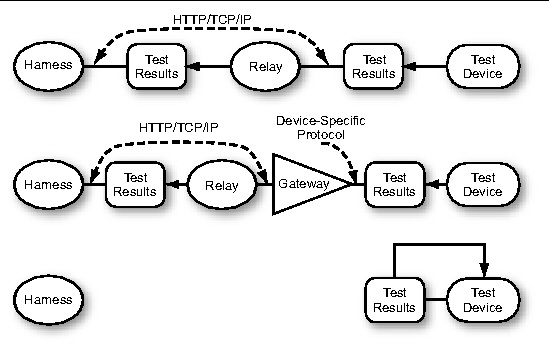| C H A P T E R 4 |
|
Connecting Test Devices |
For runtime and benchmark tests, there are several ways to connect the test device to the harness so that tests can flow to the device and test results can flow to the harness. This chapter describes the options and the details of test device-harness communication in the following sections:
The material in this chapter does not apply to over-the-air provisioning (OTA) tests. Those tests are structured very differently and have no options for communication. In particular, the means of bundle transfer and result disposition described in this chapter has no effect on the execution of OTA tests. See OTA Provisioning Test Architecture for information.
Test devices must meet these requirements:
In addition to the device requirements, a test device must support at least one of the connection options described in this section. The connection options support the transfer of tests and results:
When you direct the harness to run tests, the harness packs groups of tests into MIDP MIDlet suites, which are called test bundles. To run the tests in a bundle, the bundle must be transferred to the test device, installed, and launched. The bundles can be transferred by HTTP or over a local link, such as a serial cable. You specify your choice in the Tests and Bundles section of a template or configuration. The operations for installing and launching a bundle are device dependent.
When test bundles are transferred by HTTP, the harness repeatedly creates test bundles and sends them to the Relay. You then download a bundle from the Relay, install it and launch it, which causes the tests to run.
The Relay can transfer test bundles over a TCP/IP connection that supports HTTP version 1.0 or 1.1. The device itself does not need to support HTTP over TCP/IP if bridge hardware or software between the test device and the Relay can act as an HTTP client on behalf of the device. A WAP gateway is one example of such a bridge. FIGURE 4-1 illustrates HTTP test bundle downloading with and without a bridge.
FIGURE 4-1 Test Bundle Transfer Options - HTTP

The alternative to HTTP bundle transfer is to use a local link, such as serial, infrared, or Bluetooth. This option requires cooperating software on the harness host or another host. In the Configuration Editor, specify a directory into which the harness stores the test bundles. Direct the software to download the test bundles from the directory to the test device. FIGURE 4-2 illustrates test bundle transfer by a local link.
FIGURE 4-2 Test Bundle Transfer - Local Link

For test results to be transferred from a test device to a harness, the test device’s Java software or a gateway interposed between the device and the Relay, must support HTTP version 1.0 or 1.1 over TCP/IP. If the test device or gateway does not support HTTP, test results are not sent to the harness. Instead, test results can be displayed on the device. FIGURE 4-3 illustrates the possible test result disposition options:
FIGURE 4-3 Test Result Disposition Options

In the Configuration Editor, specify how tests are downloaded to the test device and how test results are handled. You can choose from the following test bundle transfer and result disposition options:
You can select this value if both of the following conditions are true:
This option is for test devices whose Java methods for HTTP communication are absent or do not work correctly. The device must still be able to download MIDlets using HTTP, which is possible if the device’s native HTTP implementation is working.
Select this value if both of the following conditions are true:
This option is for devices whose Java methods for HTTP communication are absent or do not work correctly.
If your test device supports more than one of the options consider these factors when making your choice:
When bundles are transferred using a local link and the last test run completes, you must press the Stop button so the harness is no longer waiting for more bundles to be transferred to the test device and is no longer in a run test mode.